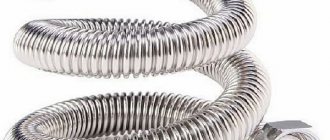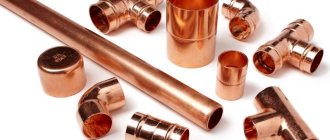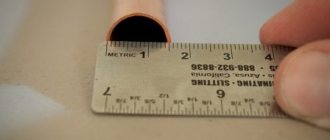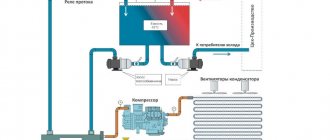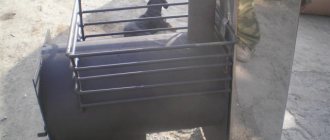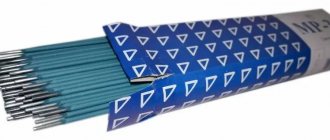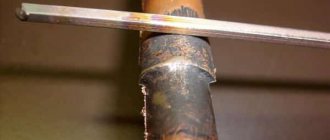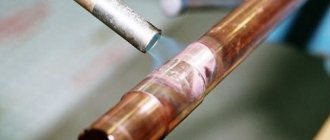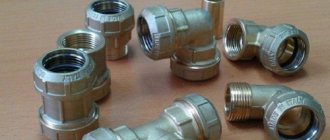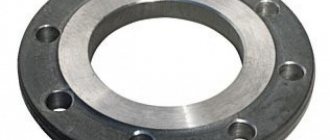Copper pipe products have long been considered a universal solution.
They are used everywhere: when laying water pipes, gas pipelines and heating mains. These products are not affected by chlorinated water, and this becomes an important factor when choosing them for work.
They are the best option for laying a city water main. After all, copper areas are not affected by corrosion and serve for a long time.
Laying a main line from such pipes is carried out using various connection options. These are: soldering and welding, as well as using fittings for copper pipes for crimping.
Pros and cons of these parts
Connecting pipelines with crimp fittings is very easy. With this method, you do not need to use high temperature or use special equipment.
This is how pipes are laid even in places of difficult access. This work requires the following tools:
- Wrench;
- Calibrator;
- Cutter.
If you compare the time and labor costs for this work, they are small. And the laid pipeline comes out sealed and lasts for a long time.
But, no matter how good such a system is, it still has drawbacks. The crimp fitting must be constantly checked and tightened. For this reason, they are not recommended to be laid under concrete.
And these parts are also designed to operate the system with low pressure. If we compare their reliability with soldering, then these fittings have less reliability.
The connection, mounted with compression fittings, becomes a structure that is used repeatedly.
It can be assembled and disassembled. But, each subsequent installation and dismantling will affect its strength.
Three main connection methods
Before connecting sections of copper pipes, they must be cut in accordance with the wiring diagram and prepared. You will need a pipe cutter or hacksaw, a pipe bender and a file. And for cleaning the ends, fine-grained sandpaper will not hurt.
Only having a diagram of the future pipeline system in hand can you calculate the required amount of consumables. It is necessary to decide in advance where and what diameter the pipes will be installed. It is also necessary to clearly understand how many connecting elements are required for this.
Option #1: Welding copper pipes
To perform automated or manual welding of copper pipes, electrodes and gas are required to create a protective environment (nitrogen, argon or helium). You will also need a DC welding machine and, in some cases, a torch. The electrode can be graphite, tungsten, copper or carbon.
The main disadvantage of this installation technology is the significant differences in the characteristics of the resulting seam and the pipe metal. They differ in chemical composition, internal structure, electrical and thermal conductivity. If welding is performed incorrectly, the joint may even separate later.
Due to the alloying of copper as a result of the action of the deoxidizer present in the electrode, the weld seam is in many respects very different from the base metal being welded
Only a qualified craftsman can properly weld copper pipes. This requires certain knowledge and skills.
This installation option has a lot of technological nuances. If you plan to do everything yourself, but have no experience working with a welding machine, then it is better to use a different connection method.
Option #2: Capillary soldering
In domestic conditions, copper pipes are rarely connected by welding plumbing fixtures. It is too complex, requires specialized skills and is time consuming. It is easier to use the capillary soldering method using a gas torch or blowtorch.
The technology of soldering copper pipes with solder is based on the capillary rise (seepage) of the latter after melting along the gap between two pressed metal planes
Soldering of copper pipes happens:
- low temperature - soft solders and a blowtorch are used;
- high temperature - refractory alloys and a propane or acetylene torch are used.
These methods of soldering copper pipes do not make much difference in the final result. The connection in both cases is reliable and tear-resistant. The seam with the high-temperature method is somewhat stronger. However, due to the high temperature of the gas stream from the burner, the risk of burning through the metal of the pipe wall increases.
Solders are used based on tin or lead with the addition of bismuth, selenium, copper and silver. However, if pipes are soldered for a drinking water supply system, then it is better to avoid the lead option due to its toxicity.
Image gallery
To implement low-temperature welding, it is not necessary to have special equipment and special skills of the performer. You can do it yourself
How a crimp fitting works and works
This device includes:
- Frame;
- Compression nut;
- Crimping ring. Often one or two rings are placed. They increase the tightness of the joint and provide resistance to high pressures. This also extends the life of the structure.
IMPORTANT! It is recommended to purchase parts in which the seal is not simple rubber, but EPD M. Such products will last longer.
To produce these elements the following is used:
- Brass;
- Copper;
- Plastic;
- Metal.
For copper pipe products, brass fittings are most often used. They are easy to process and have a low cost when compared to copper products.
And the strength of brass is equal to stainless steel, and it fits much easier. To increase the stability of brass fittings, they are plated with nickel.
When purchasing such parts, you need to take into account their weight (do not take light items). Experts also recommend purchasing them from a reputable manufacturer.
This way, finances will not be wasted, and the highway will operate smoothly and reliably.
Installation of type A fittings
For the quality of the connection, the pipe must be slightly deformed. This will guarantee the tightness of the assembly.
Installation of assembly parts of this type is performed in the following sequence:
- The required diameter of the pipes is selected and cut to the required size.
- The cut is cleaned of burrs, scratches and dirt. If necessary, the hole is calibrated.
- The ferrule is installed, then the pipe is inserted into the fitting. First, the crimp nut is screwed on by hand, and then tightened with a wrench.
Types of crimp fittings
Video
Copper fittings
These devices come in the following types:
- Tee. For installation of branches in one direction;
- Cross. For a branch device in two directions;
- Clutch. Used to connect pipe blanks that have the same diameters;
- Retraction. Apply to create a turn;
- Stub. Placed on the end of the cut piece.
For the joint of pipes that have the same diameters, straight parts are used, and for different diameters a transitional option is used.
By type they are divided into:
- Threaded;
- Compression;
- Capillary;
- Press fittings;
- Self-locking.
Types of devices
There are several types of devices:
1.tees, which are used for branching in one direction.
2.crosses are used to make branches in several directions.
3. couplings are used to connect products having equal diameters.
4. Bends are used to form turns.
5.plugs are installed at the ends of the workpieces.
To connect pipes with equal sections, parts with a straight design are used, and if the diameters are different, adapters are used.
Types of transition elements:
1.threaded type.
2.compression type.
3. capillary type.
4.press - fitting.
5.self-locking.
Threaded elements
They are simple and durable, their design does not require modification. The best option for these parts are brass fittings. They are characterized by increased resistance to corrosion, and are installed in those places of the pipeline where fixation to the wall is required.
IMPORTANT! It is not recommended to combine such fittings with pipelines made of plastic, metal-plastic and copper. Because during twisting, this part can easily crush the workpiece made from the specified materials.
General information
The optimal solution during the installation of water supply in cities is the use of pipes made of this material. Copper products are not subject to corrosion and have a long service life.
Reference! Products are mounted using different methods: by soldering, welding, or using fittings for copper pipes for crimping.
Positive and negative characteristics of products. Installation of pipelines using compression fittings is quick and easy. This method does not require the use of high temperatures or special equipment.
The installation method allows you to work in hard-to-reach places; for this you need tools in the form of:
1. spanners.
2. calibrator.
3.cutter
The time required to carry out the work is short, but the pipeline is obtained with a high level of tightness and can serve for a long time.
The disadvantages of the element for connecting the structure include the need to periodically check if the fitting needs to be tightened.
Important! Since the fittings require constant checking, they cannot be installed under a concrete screed.
The parts are designed for systems with low pressure, since the fastening is less reliable than that of pipes connected by soldering.
If you use crimping devices during connection, the design can be used many times.
Attention! The joints can be disassembled and reassembled many times, but the strength of the connection will gradually decrease.
Compression
Situations arise when it is not possible to use open fire, then compression fittings are installed on copper pipelines. They allow you to easily work with workpieces of unequal diameters, and the material may be different.
They come from:
- brass;
- copper;
- metal-plastic;
- plastic;
- become.
They have a crimp ring; it secures the part to the pipe and creates a fairly airtight joint. This ring is tightened manually using a wrench and a connection nut.
IMPORTANT! It is very convenient to work with these elements in areas with difficult access.
Copper pipe rolling process
When installing heating and plumbing systems, the parts of which are made of copper, such technological operations as flaring or beading of copper pipes are often performed. With this operation, which can be performed using various tools, the geometric parameters of the ends of the connected pipes are changed without changing the performance characteristics of the product.
Flared copper pipes
The simplest tool with which this operation can be performed is a rod with a conical tip, which is inserted into the end of a copper pipe and rotated in it until it acquires the desired geometric shape. Although this device is quite simple to use, it does not allow for high-quality flaring, ensuring uniform pressure on the walls.
A more effective device for performing flaring is a device that consists of a clamp that exerts pressure on the working cone, as well as a stand with several holes or one universal one into which copper pipes of various diameters are inserted. For the installation of heating or plumbing systems consisting of copper elements, home craftsmen most often use just such devices.
Specialists who professionally install communication systems consisting of copper elements use devices for flaring, the design of which includes an eccentric and a safety ratchet. The ends of the pipes, on which the nuts are previously put on, are evenly rolled out on such a device along their inner surface, for which an eccentric is used.
Copper pipe flaring kit
A ratchet, which limits the force exerted on the end of the pipe, is necessary in such a device so that the walls are not pressed through when there is excessive pressure on them. The big advantage of using such a professional device is that when used, small grooves and dents do not form on the inner surface. It is these grooves and dents that occur when using more primitive devices that are the most likely sources of leaks, which ultimately significantly reduce the life of the pipeline.
Capillary connection elements
They are more suitable than others for pipe products made of copper and steel. On the inside, under the cut thread, they have a very thin wire made of copper, tin, or silver. This wire becomes the solder.
Video
Pressing copper pipes. Water, gas.
The workpiece, which is coated with flux, is inserted into the fitting. The joint is heated with a burner. Heating is carried out until the molten solder fills the space.
After this, the joint is left to cool. After some time, the joint area is cleaned with special cleaning agents for working with copper.
The described connection is considered the most reliable, and for copper products it is better suited than others.
Connecting pipes using soldering
Let's consider connecting copper tubes with fittings followed by soldering, which can be low- and high-temperature.
In the first method, soldering is carried out at a temperature of 300 ºC. The second method is used when installing systems with high loads for industrial purposes. Couplings are used as connectors for copper pipes; tin-lead solder and flux are additionally needed.
The pipe soldering technology will be as follows:
- First of all, a pipe of a certain size is cut. This process must be carried out carefully, taking into account the size of the existing fittings.
- The ends of the pipes must be inspected - there should be no defects such as chips, cracks or burrs. If they are not eliminated, there will be problems with the tightness of the connection after all the work is completed.
- After making sure that the ends are clean, you can start connecting. Due to the fact that several pipes will be connected, and they can be of different sections, the fittings must be selected accordingly.
- Next, the end of the pipe and the inner walls of the couplings should be treated with flux, which will degrease the surfaces to obtain the highest quality connection.
- Now the end of the pipe is threaded into the copper tube connector and heated. It must be selected so that the cross-section is 1-1.5 cm larger than the cross-section of the pipe. The pipes are heated with a gas burner. The gap between the pipe and the coupling is filled with molten solder. Currently, you can find any type of solder on the market to suit your needs, so there should not be any problems with the choice.
- After the solder is evenly distributed around the circumference, the parts to be joined must be left until it has completely hardened.
At the final stage, you need to check the connectors for the copper pipes and the entire system by running water into it. At this moment, not only the system will be checked, but it will also be cleaned of flux residues, which over time can cause metal corrosion.
Self-locking connectors
Video
Copper pipe rolling
Self-locking elements are mechanical type devices. It is based on inner rings, and one of these rings has teeth. When pressed with a puller key, they fit tightly into the other ring.
This type of joint is reliable and durable. This part can be used more than once, because with the help of a puller key, it is very easily removed.
This type of fitting is made from copper, and it perfectly holds workpieces of any type of cross-section and different materials together. This is a very convenient way for a pipeline made of various pipe products and fittings.
Advantages of copper pipes and their disadvantages
At present, it is impossible to say for sure why copper pipes for water supply are used extremely rarely in the CIS. One of the likely reasons is the high cost of such products, although if we take into account the costs of repairs in one particular apartment, the difference is not so great.
Another factor is the huge variety of alternative options on the building materials market, which can be a worthy replacement for steel pipes, which are prone to oxidation and difficult to install. However, most likely the reason is still in long-rooted habits passed on from generation to generation.
Let's look at the main advantages of copper pipes:
- they are practically not subject to oxidation and corrosion;
- the threshold of permissible temperatures for pipe operation ranges from -110 ℃ to 250 ℃;
- the properties of the material make it possible to avoid the formation of any deposits on the internal walls of the pipes;
- The service life of copper pipes for water supply is quite long, and the costs of their installation and maintenance are extremely low.
However, it is impossible not to note some of the shortcomings of copper pipes for water supply:
- With some metals, in particular aluminum and steel, copper forms a galvanic couple. Therefore, if even a very weak current flows at the point of contact between the thread and the copper pipe, serious complications can occur.
- Copper is an excellent conductor, which in some situations can cause electric shock. This can happen even through no fault of yours - for example, if, as a result of a breakdown of your neighbors’ washing machine, a breakdown occurs between the phase and the ground to the water supply.
- Installing copper plumbing pipes and fittings is quite labor intensive. Although the principle of installing compression fittings will not differ from, say, working with metal-plastic pipes, however, much more effort will have to be applied (read: “How to install copper pipes correctly - expert advice”). If the joining of pipes is carried out using the soldering method, then consumables (solder, flux), a special tool (blowtorch), and also skills will be required.
How to install crimp fittings on a copper pipe
Video
Radial presses for crimping fittings
It should be noted right away that this type of connection does not require special equipment, and you can make it yourself.
According to European standards, crimp connectors are divided into two types and are marked with the letter A or B.
Type A. Used exclusively for laying above-ground pipeline networks made from semi-solid copper or stainless steel.
Type B. It is used for above-ground and underground communication systems, created from soft and semi-hard types of copper with thick-walled pipes.
IMPORTANT! To get a very reliable joint, you must act strictly according to certain rules and instructions.
How to install fittings for type A crimp:
Video
Pressing copper pipes is quick and easy! (4)
- An element of the required size is selected. This is easy to do because all connecting structures are produced according to the same European standard;
- A pipe blank of the required size is cut and the burrs are removed. The sections are checked with a gauge. Contamination is removed from the workpiece, poorly processed edges and damage are cleaned. A crimp ring is placed on the workpiece.
ADVICE. It is recommended to wet the joint with water, this will prevent the seal from slipping and breaking;
- The end of the pipe is inserted into the connector until it stops. After this, the clamping nut is tightened. First they twist it by hand, and then take a wrench.
ADVICE. There is no need to apply excessive force during these actions. This will not improve the tightness of the connection. If cheap parts are used for work, then there is a risk of extruding the ring, and then the joint will not be reliable.
After such work, the pipe may be slightly deformed. This will confirm that the connection is made airtight.
How to install type B compression fittings
Video
Copper pipes (installation, soldering)
This type of crimp connection elements is mounted in almost the same way as in the first case. The cutting area is thoroughly cleaned of dirt. The thread should also be free of dirt. Only light lubrication of the threads with machine oil is allowed.
This will make it easier to wrap the pipe. It is necessary to ensure that the seal cone is pressed against the inside of the workpiece, and the edge of the workpiece itself must be flared.
You need to choose the right key. It should not become loose; this will damage the nut. For example, for a diameter of 54 mm, you will need a 750 mm wrench.
Features of connecting these fittings to pipes
Video
The cost of a line made of copper pipes is high, so when purchasing materials it is advised to follow the following rules:
- It is necessary to give preference to homogeneous materials, so the entire structure will last longer;
- Do not combine copper and unalloyed steel. Electrochemical processes between them have a detrimental effect on the connection. In this case, the steel elements become covered with rust;
- If it is impossible to do without using dissimilar materials, then steel products are mounted in front of copper ones in the direction of fluid movement;
- Copper pipes go well with their PVC network elements. There are no negative consequences in this situation.
Features of installing a copper pipeline
Since the cost of a copper pipeline is very high, it is recommended to adhere to a number of rules when purchasing materials:
- It is preferable to buy pipes from one material; this approach will increase the durability of the structure.
- The connection of copper to unalloyed steel is extremely unreliable. Their interaction gives rise to electrochemical processes that destroy the structure. At the same time, steel parts lose their corrosion resistance and fail much faster.
- If a heterogeneous connection is planned, it is necessary to place steel pipes in front of copper pipes in the direction of transportation of liquid or gas.
- But copper pipes can be used together with their PVC elements. Such a connection will be reliable and no negative consequences will arise.
- PVC pipes are becoming increasingly popular for sewer installations. This is due to their low cost relative to metal products, while their durability is almost the same, as is their strength.
Conclusion
Compression fittings are often used when installing copper pipelines, since such a connection is practical and easy to implement. At the same time, it is important not to skimp on the quality of products, otherwise the structure will quickly require repairs. The more responsible the installation of the pipeline is, the longer its service life will be.
What types are produced?
Fittings can be classified according to the material from which they are made, by the method of installation, as well as by shape and purpose. They are used for soldering, welding and detachable connections.
Depending on the material, fittings can be metal (made of metals and alloys) or plastic (made of low-density polyethylene or polypropylene).
According to the installation method, they are divided into three groups:
- threaded;
- crimping;
- for soldering or welding.
Compression fittings, in turn, can be crimped either using a special tool or by tightening the nut ring. Both the ring and the union nut are part of the design and are always supplied as a set.
The division by purpose is as follows:
- connecting - couplings, bends, fittings, adapters from one diameter to another or from one connection method to another;
- changing the direction of pipelines - bends, elbows. Sometimes, simultaneously with a change in direction, the diameter or installation method also changes;
- branching - tees, crosses, which allow you to divide pipelines into several directions.
In the production of metal products for welding, steel is often used, but recently copper fittings for soldering, as well as threaded components, have become most widespread.
Threaded parts for metal pipelines are made of copper alloys - brass or bronze. They are stronger than copper.
Connections are made by screwing one thread onto another using a flax seal, plumbing thread, or fum tape. The dimensions of threaded elements are usually specified in inches and fractions of an inch.
Plastic
For the installation of polyethylene pipelines, HDPE fittings (made of low-density polyethylene) are used. They are threaded, crimped with a nut or soldered.
The design of polyethylene compression fittings includes, in addition to ferrules, rubber sealing rings. When installing the connection, these rings are installed in the gap between the outer surface of the pipe and the inner surface of the fitting.
Polyethylene components for soldering are made in such a way that the tube is tightly, but without force, inserted into the fitting after heating with a special soldering iron.
Parts made of polypropylene are used for the installation of pipelines made of the same material. Such joints are made only by soldering using.
Sometimes they use fittings made of polypropylene, into which metal threads are soldered. Such products are necessary where it is not possible to create a permanent connection due to technological requirements or due to poor access to the installation site. They are also used to install plumbing fixtures, such as faucets.
Pipes and hoses made of polyvinyl chloride are often used in industry and in everyday life. They are pulled onto the fittings and secured with crimp clamps.
Sometimes PVC pipes have a heat-shrinking effect, and for reliable contact it is enough to simply heat the end of the tube put on the fitting. After cooling, the hoses press the fitting tightly.
Metal-plastic
Until now, all types of connecting elements considered were made of the same material from which the pipes were made. For soldering, this is obvious, because the material of the pipes and fittings must have the same melting point.
Threaded and crimp fittings for plastic pipes are also made of plastic. But there is another type of pipes - metal-plastic.
Their walls consist of two layers of polyethylene, between which a metal (usually aluminum) layer is sealed. This layer reinforces the pipes, and polyethylene protects it from corrosion.
Such pipes are connected with metal compression fittings. The connection can be dismountable - in the case of using fittings with nuts, and non-separable - in the case of using press fittings crimped with special pliers.
Made of copper and bronze
The most common copper pipe connections are either crimp or solder. They are made from copper or bronze. Copper tees, elbows, and various types of solder couplings are in demand, without which it is impossible to assemble a pipeline.
Copper compression fittings include a continuous ferrule and a union nut.
If a joint is dismantled in order to replace a section of the pipeline, the ring cannot be reused, since it remains tightly pressed onto the replaced pipe. In the retail chain, rings for copper compression fittings of various sizes are sold separately.
Sewer plastic pipes diameters, prices
Every owner wants everything in his household to work, nothing to break, and to be easy to maintain and install. And sewerage is no exception. It needs to require as little attention as possible - it’s very inconvenient if it gets clogged, but it’s no less unpleasant to clean it
If you want to have a trouble-free drainage system, pay attention to plastic sewer pipes. They are gradually replacing cast iron ones, and all because they cost less, are easier to install, have a wide range - different diameters and lengths, almost no deposits form on their smooth walls, and even have a service life of about 50 years. This whole bouquet of properties determines their popularity
This whole bouquet of properties determines their popularity.
Plastic sewer pipes are made from various polymers and their compositions
Types of plastic sewer pipes
Products made from different types of polymers are sold under the general name “plastic”:
- polyethylene (PE): high pressure (HDPE) - for internal sewerage distribution,
- low pressure (LHP) - can be laid outside, in trenches (have greater strength),
polyvinyl chloride (PVC), polypropylene (PP)
And a number of other thermoplastics and their combinations, but they are rare - people prefer to use already known materials.
The material of plastic sewer pipes is selected depending on the application. For example, polypropylene is more suitable for installing sewerage inside a house or apartment. It has a higher operating temperature range - it normally tolerates environments up to 70°C, and for a short time - up to 95°C. If you have various household appliances that discharge waste hot water into the sewer, this will not be superfluous. PVC pipes, which have lower prices, are more appropriate when laying external sewers - here the drains are usually already mixed, so the temperatures are lower and PVC can withstand them without harm (working up to +40°C, short-term increase to 60°C).
An example of an in-house sewerage system made from plastic pipes
Sewer pipes can also be smooth or corrugated. Moreover, not only siphon bends can be corrugated. There are profiled pipes for sewerage with an internal smooth wall and an external ribbed one. They have greater strength - they can better withstand compressive loads (they have increased ring rigidity) and can be buried to great depths. Available in diameters from 110 mm to 1200 mm.
Dimensions and diameters
Sewage plastic pipes, unlike water and gas pipes, are produced in the form of lengths of 50 cm, 100 cm, 200 cm, etc. - up to 600 cm. The maximum length is 12 meters, but some manufacturers can make longer sections upon request. When laying long routes, this is convenient - there are fewer connections, fewer possible places for problems to arise (leaks or blockages).
Another important characteristics of plastic pipes are diameter and wall thickness. In the markings they usually go side by side: the numbers are 160 * 4.2. What it means: the outer diameter of the pipe is 160 mm, the wall thickness is 4.2 mm. It’s worth remembering here that manufacturers indicate the outer diameter of plastic pipes, and many calculations and planning require knowing the inner one. It is easy to calculate: subtract twice the wall thickness from the outer wall: 160 mm - 4.2 mm * 2 = 151.6 mm. Calculations and tables usually show a rounded result—in this case, 150 mm.
Parameters of sewer plastic pipes
In general, the industry produces plastic pipes for sewerage with a diameter of 25 mm. The maximum cross-section depends on the type of pipe (smooth or corrugated) and the material from which it is made. For example, smooth PVC sewer pipes can have a diameter of up to 630 mm, and profiled two-layer pipes can have a diameter of up to 1200 mm. But these dimensions are of no use to homeowners or apartment dwellers. In private housing construction, diameters up to 100-110 mm are mainly used, rarely up to 160 mm. Sometimes, for a large cottage with a large number of plumbing fixtures, a pipe of 200-250 mm in diameter may be needed.
The organization of sewerage at the dacha is described here.
How to choose a diameter for connecting plumbing fixtures
According to the rules, a calculation must be made; it is fully spelled out in SNiP 2.04.01085. This is a complex matter, a lot of data is required, so few people really think as it should. Over the years, accumulated practice has made it possible to derive the average diameters of polyethylene sewer pipes for each of the plumbing fixtures. You can safely use these developments - all calculations usually come down to these dimensions.
Labeling and cost
Round copper products for heating and plumbing with walls from 0.8 to 10 mm thick are manufactured in accordance with GOST 617-90. In subsequent years, the document was repeatedly refined, so a different digital value may be indicated in the marking. Depending on the purity of copper, its grades according to GOST 859-2001 are marked as M1, M1p, M2, M2p, M3, M3p. The composition of the material has little effect on the main characteristics of the pipes, so they are allowed to be neglected.
From the standard labeling you can find out:
- Preparation method. Drawn ones are indicated by “D”, and welded ones are indicated by “C”.
- Cross section shape. For the pipes in question, it is round, so it is marked “KR”.
- Precision manufacturing. Normal wall thickness and diameter size are designated “N,” and increased thickness is designated “P.” With normal accuracy of wall thickness and increased diameter, “I” is indicated, and if vice versa, then “K”.
- Length. “ND” is an unmeasured pipe, “MD” is a measured pipe, “KD” is a multiple dimension index, “BT” is a coil.
- About special conditions. Improved characteristics are designated by the letter P. Increased ductility is “PP”, strength is “PT”, accuracy is “PS”, cutting accuracy is “PU”.
Other manufacturing features are not significant
For example, they pay attention to increased accuracy in curvature “K” if they want to install a pipeline with an ideal appearance and are willing to overpay. The standard marking looks like this: DKRNM 30×2.0×2050 M1 GOST 21646-2003
This means:
- the pipe is made of M1 grade copper;
- drawn out;
- round shape;
- manufacturing accuracy is normal;
- soft;
- outer diameter 30 mm;
- wall thickness 2 mm;
- length 2050 mm;
- according to GOST 21646-2003.
According to European standards DIN 1412, copper pipes for installation of water supply and heating systems are marked EN-1057. It means that phosphorus has been added to their composition, which increases oxidation resistance. EN-1057 is the number of the standard to which the pipe is manufactured.
On average, prices for copper products with walls 1 mm thick for heating installation in an apartment or private house, depending on the size of the internal cross-section, are:
| Diameter, mm | 6 | 8 | 10 | 12 | 15 | 18 | 22 | 28 | 35 |
| Price per 1 meter, rub. | 110 | 145 | 180 | 210 | 220 | 235 | 295 | 380 | 600 |
Pipes with walls 1.5 mm thick cost one and a half times more. Prices are indicated for products of Russian manufacturers. Foreign analogues will cost more due to transport and customs costs.
Types and installation
Fittings vary in many parameters - shape, place of application, installation method, purpose and others. The most popular types of copper spare parts in Russia are threaded, compression, crimp, and copper solder fittings.
Threaded
Designed for installation on a pipeline with a thread at the end. The part also includes rubber gaskets that improve the tightness of the connection. The thread can be located both inside and outside the part. The main advantages are low price, large selection, versatility, ease of installation (if there is a thread). Installation:
- A thread is applied to the end of the pipe that corresponds to the diameter of the part. Often pipes with already applied threads are used - then the first installation step is skipped.
- An anti-corrosion coating is applied to the end of the pipes. A rubber gasket is mounted inside the fitting, which is included with the device.
- After this, the spare part is screwed to the pipe using a thread. If necessary, the tightness of the part can be adjusted using crimp bolts.
Threaded connections have been widely used in the past. But they are gradually falling out of use. The reason is simple - if there is no thread, the worker will have to make it himself. Therefore, when choosing, preference is given to compression parts. They do not require additional equipment or physical effort to install.
Compression (crimp)
They are not made from pure copper, but from a brass-based alloy with the addition of nickel. All parts of this type consist of three elements - a body, a ferrule nut and a sealing ring. Installation:
- The pipe is cut to the required size using a hacksaw or metal shears. After this, the surface is cleaned using hard sandpaper. In some cases, this step is skipped.
- The crimp nut and ring are placed on the pipe. The fitting is put on so that it comes into contact with the O-ring.
- The final tightening of the part is performed using a nut. Periodically (at least once a season) it is necessary to inspect the structure - if necessary, the nut must be re-tightened.
Press
They look like simple parts with a soft press sleeve without thread. The spare part consists of several structural elements - a crimp ring, a housing, a press sleeve and others. For installation, the housing with all the elements is manually put on the pipe. After this, the edges of the press sleeve are pressed using a crimp wrench. As a result, a strong, sealed connection is formed that will securely fix the part to the pipeline. Crimping a part is very simple; the worker does not have to make any serious physical effort to carry out the work.
Please note that pressing using another tool is problematic, so be sure to buy a wrench before installation
Solderable
Soldering is a popular method that can be used to securely attach an element to a riser. To carry out the work you will need a capillary gas burner and a flux solution.
Solder fittings are mounted as follows:
- Before soldering, the pipeline is cut to the required size, and then the edge is cleaned using coarse sandpaper.
- A protective flux is applied to the surface of the pipeline to prevent corrosion. Flux should be applied to the area that will be in contact with the edge.
- The spare part is installed on the surface of the riser. After this, capillary welding is performed using a gas torch. During welding, solder is formed, which securely fixes the spare part to the surface of the pipeline.
